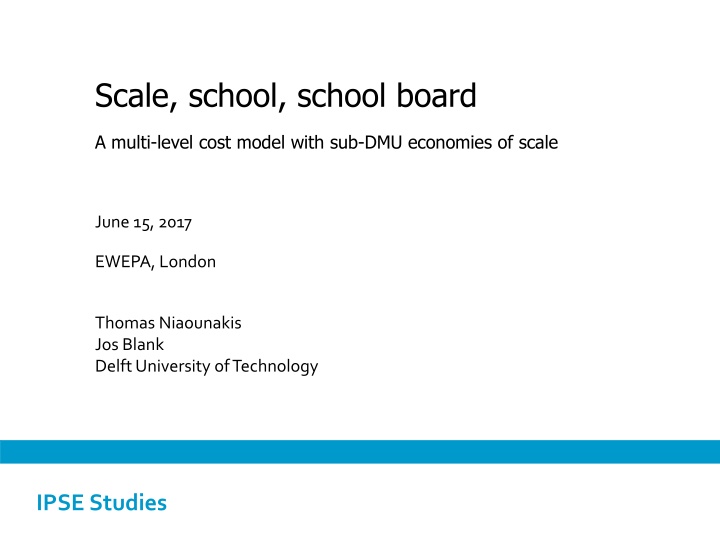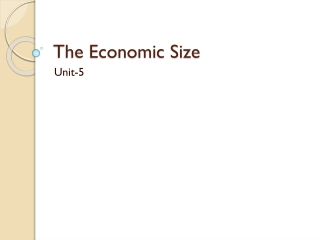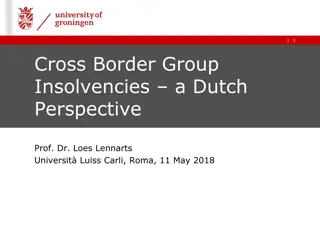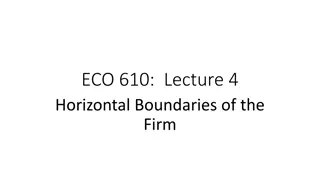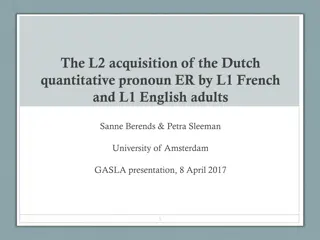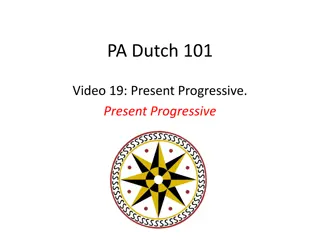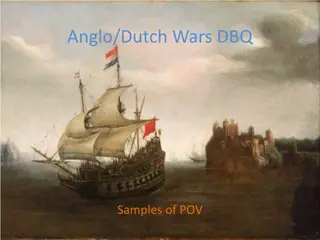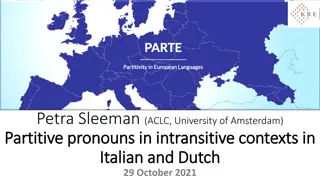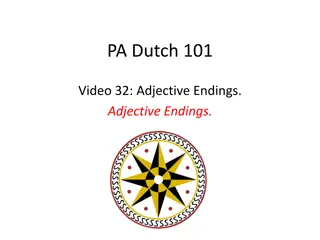Economies of Scale in Dutch Primary Education: A Multi-level Cost Model
This paper explores economies of scale in Dutch primary education, focusing on school boards and school compositions. The study examines the impact of school size variations on cost determination at both levels, considering the challenges of limited input data availability. Different solutions are proposed, including incorporating school composition as a determinant of efficiency and formulating board costs based on individual school cost functions. The literature review highlights existing research on economies of scale in education, emphasizing the need to distinguish between district/ board and school-level observations.
Download Presentation

Please find below an Image/Link to download the presentation.
The content on the website is provided AS IS for your information and personal use only. It may not be sold, licensed, or shared on other websites without obtaining consent from the author.If you encounter any issues during the download, it is possible that the publisher has removed the file from their server.
You are allowed to download the files provided on this website for personal or commercial use, subject to the condition that they are used lawfully. All files are the property of their respective owners.
The content on the website is provided AS IS for your information and personal use only. It may not be sold, licensed, or shared on other websites without obtaining consent from the author.
E N D
Presentation Transcript
Scale, school, school board A multi-level cost model with sub-DMU economies of scale June 15, 2017 EWEPA, London Thomas Niaounakis Jos Blank Delft University of Technology IPSE Studies
This paper addresses economies of scale in Dutch primary education Main unit of observation: school boards Focus of this paper: including school composition in a model of school board cost 2 IPSE Studies
3 IPSE Studies
Motivation Dutch school boards (the DMU s) govern up to 30 schools Among boards, there is substantial variation in school composition terms of school size Scale effects may be determined at the school level rather than school board level (small schools receive additional funding) Input data only available at board level Relevant: Dutch government has implemented some soft regulation to limit school and school board size and is currently revising 4 IPSE Studies
Outline Objective Incorporate school composition information in a school board cost function to test for economies of scale at both levels Main issue Input (cost, factor prices) data observed only at the DMU or board level 5 IPSE Studies
Outline Explored solutions (work in progress!): Efficiency framework include school composition as determinant of school board efficiency Aggregation Formulate board cost as an aggregation of individual school cost functions Issue is reduced to a measurement problem Extrapolation/accounting Infer cost structure from single-school schoolboards or assess school cost manually 6 IPSE Studies
Literature There is a large strand of literature addressing economies of scale in education in a variety of disciplines (productivity, education, accounting) Roughly speaking, there seems to be consensus that small schools operate under economies of scale Less clear when diseconomies of scale kick in Often, the unit of observation is either the district/board OR school -> a matter of data See a.o.: Andrews et al. (2002, EER) Colegrave et al. (2009, EER), de Witte et al. (2015) Wales (1973): among the first to recognize the distinction between school districts and schools in assessing scale effects 7 IPSE Studies
Data Observed at the DMU (school board) level Cost data Factor prices: wages, material price index (only time variant) Observed at the school level Output: enrolment, casemix Environment (municipality level): socio-economic variables 2008-2015, 3.481 observations Limited within variation -> identification relies on cross-sectional variation -> effectively there are ~700 observations 8 IPSE Studies
Sol. 1: Efficiency framework ln??= ? ??,??,?? + ??+ ??, ??= ? ???, ,???,? + ?? ??= enrolment at school board ? ???=enrolment at the ?th school of school board ? ?=number of schools governed by school board ? Estimate using some single step estimator Estimation by Battese & Coelli (1995) U is a function of school composition. We include: ? ? ? Span of control cost : number of schools ??? Average school size of school board ? 2 squared avg. school size to allow for U shape ??? 9 IPSE Studies
Sol. 1: Efficiency framework Naive estimation (no school composition indicators) Estimation including school composition Variable constant Enrolment Enrolment x enrolment Estimate Variable constant Enrolment Enrolment x enrolment Estimate -0.269*** -0,315*** 1.015*** 0,999*** 0.067*** 0,001 Factor price Socio-economic index 1,000 Factor price Socio-economic index 1,000 0,009*** 0,025*** Efficiency Intercept Average school size Squared average school size Number of schools ?2 ? Mean efficiency 0,649*** -1,365*** 0,352*** 0,065*** 0,065 0,903 0,879 ?2 ? 0,041 0,901 0,866 3471 Mean efficiency N N 3471 10 IPSE Studies
Efficiency framework Economies of scale at the board level dissapear completely after controlling for school composition A u-shaped relation is estimated between average school size and (in)efficiency Optimum school size is estimated at 480 pupils School boards with more schools are estimated with higher inefficiency 11 IPSE Studies
Sol 2: aggregation Cost of school ? of school board ?: ???= ? ???,???,??? Cost of school board ?: ? ??= ??? ?=1 Issue: aggregation of individual cost functions is only feasible for functions that specificy cost in levels as we observe ??= ??but not ?? and thus ln?? 12 IPSE Studies
Aggregation What function to describe ???? Example with a simple quadratic cost function ? ??= ?=1 = ?=1 = ??0+ 1 ???+ ?11 ??? ??? 2 ? ?0+ ?1???+ ?11??? 2 In comparison, a na ve quadratic cost function equals: ??= ?0+ 1 ???+ ?11 ??? 2 Work in progress: other possible forms are explored We now assume a fixed cost per school: ?0 In the translog fixed cost = 0 13 IPSE Studies
Aggregation: results Dependent variable: Cost (in level, variables weighted by enrolment and divided by factor price index) Variable Number of schools Enrolment Enrolment x enrolment Estimate 199,100*** 3,789.130*** 1.202*** ?2 0,99 This points towards a U-shaped average cost function at the school level Optimum school size estimated at 440 14 IPSE Studies
Some thoughts Prelimary results suggest that school size matters more than school board size Optimum school size is estimated at 440-480 pupils Efficiency framework: No aggregation required, conventional efficiency analysis feasible Assumed scale mechanism modelled through efficiency channel Aggregation: Choice of functional forms are very limited, only feasible in low- complexity technologies (such as education) For policy makers, attractive property is transparancy (parameters directly interpretable) Optimum scale estimate is rather sensitive to the specification 15 IPSE Studies
Preliminary conclusions The size of schools within boards matters for drawing inference on scale effects Failing to account for this may lead to biased estimates Work in progress: Include environmental variables at the school level Explore more flexible functional forms in the aggregated model Compare performance of both approaches and check robustness of the U-curve -> both approaches are still rather restrictive Allow for school board scale effects in the aggregated model 16 IPSE Studies
